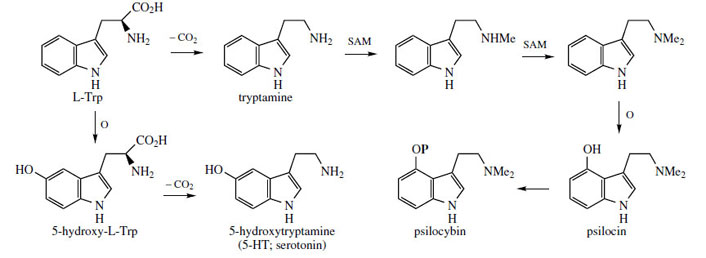Simple Indole Alkaloids
Tryptamine and its N-methyl and N,N-dimethyl derivatives (Figure 70) are widely distributed in plants, as are simple hydroxylated derivatives such as 5-hydroxytryptamine (serotonin). These are formed (Figure 70) by a series of decarboxylation, methylation, and hydroxylation reactions, though the sequences of these reactions are found to vary according to final product and/or organism involved. 5-Hydroxytryptamine is also found in mammalian tissue, where it acts as a neurotransmitter in the central nervous system. It is formed from tryptophan by hydroxylation and then decarboxylation, paralleling the tyrosine → dopamine pathway. In the formation of psilocin (Figure 70), decarboxylation precedes N-methylation, and hydroxylation occurs last. Phosphorylation of the hydroxyl in psilocin gives psilocybin. These two compounds are responsible for the hallucinogenic properties of so-called magic mushrooms, which include species of Psilocybe*, Panaeolus, etc. |
| Figure 70 |
5-Hydroxytryptamine (Serotonin)
5-Hydroxytryptamine (5-HT, serotonin) is a monoamine neurotransmitter found in cardiovascular tissue, the peripheral nervous system, blood cells, and the central nervous system. It mediates many central and peripheral physiological functions, including contraction of smooth muscle, vasoconstriction, food intake, sleep, pain perception, and memory, a consequence of it acting on several distinct receptor types. Although 5-HT may be metabolized by monoamine oxidase, platelets and neurons possess a high affinity 5-HT reuptake mechanism. Thismechanism may be inhibited by widely-prescribed antidepressant drugs termed selective serotonin re-uptake inhibitors (SSRIS), e.g. fluoxetine (Prozac®), thereby increasing levels of 5-HT in the CNS.
Migraine headaches that do not respond to analgesics may be relieved by the use of an agonist of the 5-HT1 receptor, since these receptors are known to mediate vasoconstriction. Though the causes of migraine are not clear, they are characterized by dilation of cerebral blood vessels. 5-HT1 agonists based on the 5-HT structure in current use include the sulphonamide derivative sumatriptan, and the more recent agents naratriptan, rizatriptan, and zolmitriptan (Figure 71). These are of considerable value in treating acute attacks. Several of the ergot alkaloids (page 371) also interact with 5-HT receptors.
 |
| Figure 71 |
Psilocybe
The genus Psilocybe constitutes a group of small mushrooms with worldwide distribution. It has achieved notoriety on account of hallucinogenic experiences produced following ingestion of several species, particularly those from Mexico, and has led to the description 'magic mushrooms'. Over 80 species of Psilocybe have been found to be psychoactive, whereas over 50 species are inactive. More than 30 of the hallucinogenic species have been identified in Mexico, but active species may be found in all areas of the world. Psilocybe mexicana has been used by the Mexican Indians in ancient ceremonies for many years, and its history can be traced back to the Aztecs. In temperate regions, Psilocybe semilanceata, the liberty cap, is a common species with similar activity. All the psychoactive members of the genus are said to stain blue when the fresh tissue, particularly that near the base of the stalk, is damaged, though the converse is not true. Ingestion of the fungus causes visual hallucinations with rapidly changing shapes and colours, and different perceptions of space and time, the effects gradually wearing off and causing no lasting damage or addiction.
The active hallucinogens, present at about 0.3%, are the tryptamine derivatives psilocybin and psilocin (Figure 70), which are structurally related to the neurotransmitter 5-HT, thus explaining their neurological effects. Psilocybin is probably the main active ingredient, and to produce hallucinations a dose of some 6-20 mg is required. In addition to species of Psilocybe, these compounds may be found in some fungi from other genera, including Conocybe, Panaeolus, and Stropharia. Misidentification of fungi can lead to the consumers experiencing possible unwanted toxic effects, especially gastro-intestinal upsets, instead of the desired psychedelic visions.
 |
| Figure 72 |
Gramine (Figure 72) is a simple amine found in barley (Hordeum vulgare; Graminae/Poaceae) and is derived from tryptophan by a biosynthetic pathway which cleaves off two carbon atoms, yet surprisingly retains the tryptophan nitrogen atom. Presumably, the nitrogen reacts with a cofactor, e.g. pyridoxal phosphate, and is subsequently transferred back to the indolemethyl group after the chain shortening.




